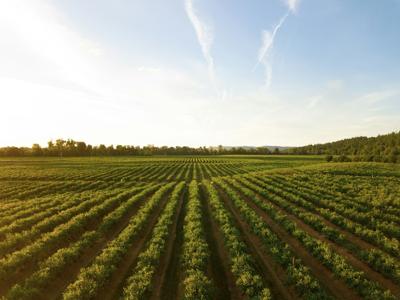
The weather holds significance in the realm of agriculture. Farmers heavily depend on weather conditions to make informed decisions about planting, irrigation, pest control, and harvesting. With the increasing impact of climate change, accurate weather forecasting has become more important than ever to support sustainable practices. In this article, we will explore the world of tailored weather forecasting for agriculture.
Exploring Weather Forecasting
Weather forecasting is a complex task. It involves collecting data from meteorological stations, satellites, and field sensors. The goal is simple: predict weather conditions by analyzing data trends and using mathematical algorithms. Weather forecast models play a crucial role in this process, helping meteorologists make sense of the information and provide accurate predictions.
Importance of Precise Weather Forecasting
Accurate weather predictions are crucial for agriculture for the following reasons:
Crop Management
Farmers need guidance on planting times to maximize crop yields. Reliable weather forecasts help farmers reduce risks associated with planting during conditions like frost or extreme heat.
Irrigation Planning
Efficient irrigation planning is vital for conserving water and maintaining soil quality. Accurate weather forecasts provide insights into rainfall patterns, allowing farmers to adjust their irrigation schedules accordingly.
Pest Management
Pests are significantly influenced by weather conditions. Knowing when specific pests might appear enables farmers to implement pest control methods at the time, reducing crop damage and decreasing reliance on chemical pesticides.
Preventing Diseases
It is crucial to prevent diseases as they tend to thrive under specific weather conditions. By utilizing weather forecasts, farmers can predict disease outbreaks and take measures such as crop rotation or applying appropriate fungicides before they spread extensively.
Timing the Harvest
Accurately timing the harvest is vital for maintaining crop quality and market value. Precise weather predictions via weather forecast models assist farmers in forecasting harvest times based on factors like temperature and humidity levels. Moreover, to safeguard the hard-earned business you've built, reliable insurance coverage, such as the offerings from Rabo AgriFinance, provides stability and protection against unforeseen challenges, ensuring resilience andsustainability in agricultural endeavours.
Ways of Gathering Weather Information
Meteorologists use many methods to gather data for creating weather forecast models, including:
Weather Stations
These stations collect data on temperature, humidity, wind speed, rainfall, and atmospheric pressure. This information is essential for understanding weather patterns.
Satellites
Satellite images provide a view of weather systems and cloud cover over regions. They offer insights into weather patterns and help identify areas of concern for agricultural purposes.
Remote Sensing
Remote sensing involves placing sensors in fields to collect data on parameters like soil moisture, crop growth, and canopy temperature. This real-time information helps farmers comprehend conditions better and make decisions. Drones equipped with sensors can gather weather information at a field level, offering weather data.
The Role of Artificial Intelligence in Weather Prediction
Artificial Intelligence (AI) contributes to improving the precision of weather forecasts by recognizing patterns within the data collected. AI algorithms can process datasets more efficiently than other methods and unveil subtle relationships between various meteorological factors.
Through analyzing weather trends and recent observations, AI models enhance their accuracy over time, delivering reliable forecasts for upcoming weather conditions. These enhanced predictions are particularly beneficial for farmers seeking to implement sustainable farming practices.
Various Weather Forecasting Models Utilized in Agriculture
Weather prediction models utilized in agriculture differ in complexity and focus on variables or geographical regions. Below are a few employed weather forecasting models:
Short-Term Prediction
Short-term weather forecasting models, also referred to as nowcasting, predict weather patterns within a short time frame ranging from hours to days. These models rely on real-time data updates and high-resolution satellite images to provide forecasts for localized areas. They prove valuable for making farming decisions, like scheduling fieldwork or ensuring worker safety during weather conditions.
Seasonal Forecasts
Seasonal forecast models aim to anticipate long-term weather trends, typically covering months to a year. These perspectives can assist farmers in planning which crop varieties to grow and when to plant them based on anticipated trends in precipitation, temperature ranges, and climate patterns throughout the growing season. Seasonal forecasts help farmers manage risks related to extreme weather events and adjust their methods accordingly.
End Note
Weather forecasting plays a role in supporting sustainable farming activities. Accurate forecasts enable farmers to make informed decisions regarding crop selection, irrigation practices, pest management, disease prevention, and harvest timing. With the increasing impact of climate change on agriculture, integrating AI methods into weather forecasting has significantly improved prediction accuracy levels.
By advancing our understanding of weather patterns through modeling techniques and state-of-the-art technologies such as drones and satellite imagery, we strive to optimize resource usage and minimize damage. This approach represents progress towards a sustainable future for farmers.



(0) comments
We welcome your comments
Log In
Post a comment as Guest
Keep it Clean. Please avoid obscene, vulgar, lewd, racist or sexually-oriented language.
PLEASE TURN OFF YOUR CAPS LOCK.
Don't Threaten. Threats of harming another person will not be tolerated.
Be Truthful. Don't knowingly lie about anyone or anything.
Be Nice. No racism, sexism or any sort of -ism that is degrading to another person.
Be Proactive. Use the 'Report' link on each comment to let us know of abusive posts.
Share with Us. We'd love to hear eyewitness accounts, the history behind an article.